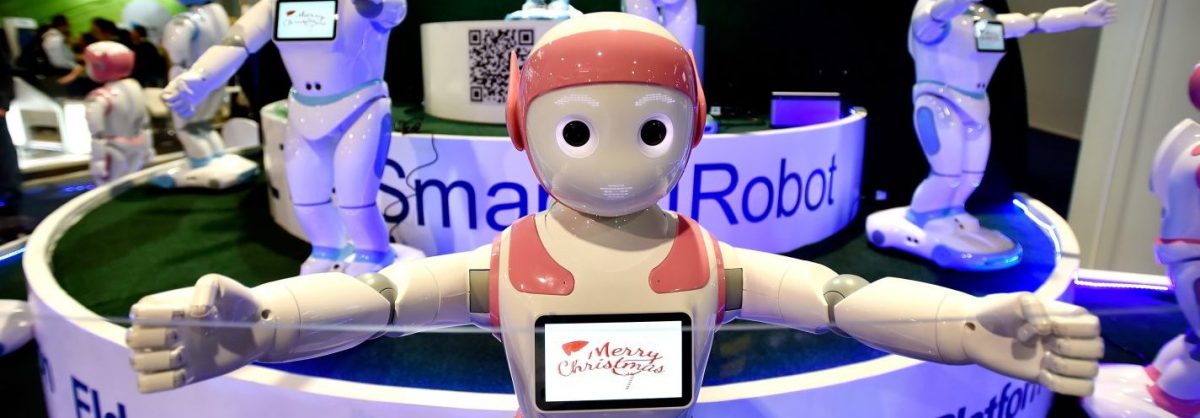Tech enthusiasts are terrible at looting.
That’s the surprising takeaway from CES 2018. Unless you count the rare occurrence of heavy rain in the Las Vegas desert that plagued the city during its second biggest convention of the year. (The Conexpo-Con/Agg concrete and construction show cemented its spot of Sin City’s top trade show.)
A veteran attendee welcomes any surprise at the Consumer Electronics Show because the same two obvious realities otherwise emerge every year: Crowds seem antithetical to the enjoyment of technology, and tech experts are still bad at predicting trends.
For now, let’s focus on the issue of completely ineffectual mass theft on January 10th. Allow the CES PR machine to set the scene:
“Today at approximately 11:15 AM, the Central Hall and South Hall bridge meeting rooms at the Las Vegas Convention Center lost power. Power in the South Hall was restored within minutes, and power has now been fully restored to all areas. A preliminary assessment indicates that condensation from heavy rainfall caused a flashover on one of the facility’s transformers. We are grateful to NV Energy for their swift assistance, to our customers and their clients for their patience and to the staff for ensuring the safety and security of all attendees and exhibitors.”
CES doesn’t express any recrimination here, but there are grounds for disappointment. There’s a proud American tradition that when any big city has a notable power outage, we loot. We break glass and load up on TVs and stereos. CES fills the entire capacity of the Las Vegas Convention Center with gear — loading 3.2 million square feet of exhibition space with said televisions, audio equipment, robots and drones. The power went out on a goodly stretch of that floor space and allowed ample time to relieve show presenters of their material burdens.
Nothing was stolen. LG even introduced a 65-inch TV that rolls up into a spindle — and no one took that, either. This no doubt Millennial malaise shows a lack of initiative that’s shocking to find in our most innovative industries. You’d think some of the boffins around here would have programmed some of those robots and drones to spirit booty away, sans-fingerprints.
The remarkably safe, non-pilfering nature of the Great Blackout of CES 2018 might be credited to the strong character of its high-minded visitors. But, when you consider how cutthroat the gadget business can be, it’s probably more sensible to credit crowd congestion for any retention of potentially stolen property.
An ever-growing epicenter of focused vice, Las Vegas has a metropolitan population of about 630,000 people, give or take the Greyhound-stranded vagrants down on Fremont Street. When CES comes to town, you can pour in an estimated additional 150,000 to 200,000 electronics industry professionals and media into the town’s mix of casinos and restaurants.
That number grows yearly as a trade show once conceived exclusively for tech business pros and reporters gradually expanded the attendance qualifications to include bloggers, then vloggers, then social media influencers and, finally, anyone who once wrote a tech manifesto on the padded walls of a cell in brown crayon.
Fortunately, some of the resulting horde spreads out to the CES satellite venues like The Hard Rock Hotel’s or The Venetian’s convention centers (as CES is now so massive the city’s official, though inadvertently darkened convention facilities can no longer contain it). Unfortunately, most of that six-figure congregation of sometimes unwashed, but would-be brainy pilgrims shoulder their way into the official convention center — and make walking something they seem to reinvent or make generally impossible.
Along similar lines, I present my brief guide to walking as though you are a CES attendee:
* If there are people behind you, avoid taking any full steps at all. Shuffle like a drunk penguin, no matter how much space stretches out before you.
* Never look where you’re headed. Glance side to side. Never shift your gaze forward. You get extra credit if you’re a lonely, nerdy male and find yourself easily distracted by the well-adorned (or unadorned) women some booths use to bring in eyeballs.
* When you do stumble into someone, ignore them. Such complete lack of social grace might also qualify you to work in one of the CES attending companies’ help centers.
Mash all that together, and this attendee finds himself oft surrounded by wonderful inventions that are both difficult to spot and impossible to touch.
If you can skirt the masses while they’re distracted by the Vegas proclivity to remove actuals skirts, it’s possible to take in the thousands of presenters from around the world offering the latest in consumer electronics and potentially life-changing inventions. It’s hard to escape the question of how so many of these companies stay in existence — not because of any lack of quality in their goods, but due to the incomprehensible number of firms making the same things.
We live in a society dominated by technology and relying on gadgetry, but there are only so many sets of headphones, Bluetooth speakers and phone cases we’re ever going to need. How do these companies stay afloat while lobbing broadsides of entirely comparable product at each other?
I’d let the real tech experts answer such a question, but they’re too busy getting their trend predictions wrong. Every CES for the last several years offered some foretelling as to what the main show theme would be and how that product, science or service would soon after that change our world. Invariably, that world decides to like what it likes without coaching and changes only at a speed it prefers.
For example, we were all supposed to be watching 3D TV by now. But, as a culture, we decided 2D (if HD) was OK. To keep the two-letter abbreviations coming, we were also supposed to have 3D printers in our houses now — up to our BVD’s in home-printed shoes, tools and pets. While 3D printing remains an emerging industrial presence, we decided as a group we don’t need them under our roofs yet because there are these things called shoe stores, Lowe’s and puppy mills.
Gesture control was supposed to have us performing Jedi mind tricks around our stereos and microwaves by now. I still like to poke mine. Wearables were set to overwhelm us — until we all saw how alluringly punchable anyone looked in a pair of Google Glasses.
This year, robots are the driving force at CES, but (while we will no doubt see our friendly droids slowly taking over some functions in our lives) they won’t become our overlords at the speed their manufacturers’ and promoters’ bank accounts would like.
CES 2018, along with every preceding show and any one to come, can offer exciting opportunities to glimpse the future, the innovative, the impossible and even the bizarre products of human endeavor. But, it’s also healthy to see the show for the aggressive hype fest it is.
This article was featured in the InsideHook newsletter. Sign up now.
























